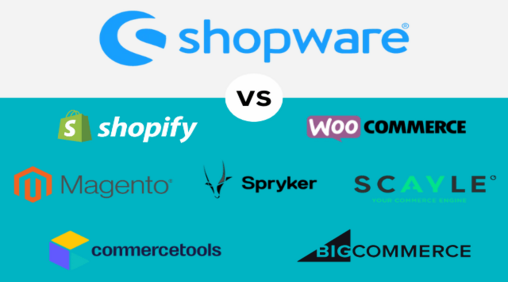Shopware is a strong e-commerce platform, no doubt. But if your brand aims to scale quickly, operate with a performance-driven mindset, and build highly individualized solutions, you will eventually run into technical and strategic limitations. Standard features are no longer enough.
You need maximum flexibility, seamless integrations, and a platform that can keep up with your pace. Especially performance-oriented brands with a clear growth focus often ask themselves: “Is Shopware still enough, or is it time for something better?”
Finding the right Shopware alternative is crucial. Whether SaaS, open source, or headless, we’ll show you which solution truly fits your setup.
When does it make sense to switch to a better alternative?
Shopware is widely used in the DACH region, technically solid, and modular. For many companies, it works well, up to a certain point. But once you need custom features, want to expand internationally, or plan to scale your tech stack, things quickly become complex and expensive.
Not every brand has an internal development team or wants to constantly deal with plugin workarounds. That’s exactly where alternatives come into play: systems that offer more agility, performance, and integration freedom without slowing down your operations.
Discover where Shopware reaches its limits and how turning those limits into an advantage can drive real growth.
Between flexibility and limitations
Shopware gives you a lot at first glance: a modular system, a flexible CMS, headless capabilities, a large community, and open API structures. For many mid-sized companies, it serves as a solid foundation. Especially in German-speaking markets, features like the Rule Builder and Shopping Experiences make it appealing.
But the moment you need real individuality, things get technically tough. Many deeper customizations are only possible through plugins or custom extensions, leading to increasing maintenance effort. And not all Shopware features are scalable or ready for international expansion out of the box.
And performance? In many setups, it remains a constant construction site, especially under high traffic or with complex business logic.
For performance-driven brands with ambitious growth goals, this becomes a real issue. Flexibility on paper isn’t enough you need a system that can execute your ideas immediately, without crushing you under development costs or forcing you into a rigid technical framework.
Particularly when comparing Shopware vs Shopify, it becomes clear how strongly SaaS architectures outperform self-managed systems in terms of scalability and maintenance especially if you want to expand internationally at speed.

Typical challenges in operation & scaling
As your shop grows, technical, operational, and economic demands increase as well. This is precisely where Shopware begins to show its limitations.
In day-to-day operations, challenges often accumulate, such as:
- Complex deployment processes when coordinating multiple developers or environments
- Slow loading times, especially with extensive custom logic or numerous plugins
- Upgrade risks, since customizations often break or become incompatible with major updates
- Missing automation for international setups, e.g., localization, currencies, or tax handling
On top of that, hosting, infrastructure, and monitoring requirements become more demanding. For D2C brands experiencing traffic peaks or relying heavily on social selling, the setup quickly becomes complex and expensive. Instead of scaling operations, you suddenly struggle with technical dependencies, plugin maintenance, and ongoing bug fixes.
That is the opposite of growth. This is why it’s worth evaluating alternatives that are more modular, more performant, and far less maintenance-heavy. Switching to a maintenance-free SaaS model like Shopify Plus can be a real game changer. It reduces pressure on your team, speeds up releases, and minimizes technical risks.
When switching systems becomes economically worthwhile
Switching platforms is not an end in itself but it can quickly pay off once operating costs, technical bottlenecks, or missed revenue opportunities start slowing down your growth.
Common scenarios where a system change becomes economically smart:
- You need custom features that, in Shopware, are only possible through expensive bespoke development.
- Your developers spend more time on bug fixes and plugin maintenance than on innovation.
- Slow loading speeds or inefficient checkout flows are measurably hurting your conversion rate.
- You want to scale internationally, but Shopware doesn’t scale cleanly with you.
- Your time-to-market for new ideas is too long, and you lose momentum.
Speed is everything in e-commerce. Brands that cling too long to a limiting system miss opportunities. Platforms like Shopify Plus or BigCommerce often offer dramatically lower total cost of ownership (TCO), faster implementation, and better conversion optimization tools, all without the ongoing technical overhead.
So when evaluating whether a switch makes sense, focus less on licensing costs and more on efficiency, scalability, and flexibility.
These platforms are strong alternatives to Shopware
You already know that Shopware no longer supports your growth ambitions. Now it’s time to find the right alternative. One thing is clear: there is no universal “best” system only the platform that best matches your business model, tech stack, and scaling goals.
SaaS, open source, headless, the market is full of options. But which systems truly deliver performance, customizability, and fast time-to-market in one package?
That’s exactly what we’ll look at next: a clear comparison of architectures and five platforms that have proven to be real alternatives.

Which shop architecture is right for your business?
Before choosing a specific alternative, you should first decide on the underlying architecture model. The choice between SaaS, open source, or headless will fundamentally determine how flexible, low-maintenance, and scalable your e-commerce system is and how much technical expertise you need internally.
-
SaaS (Software as a Service): A fully hosted cloud solution that is ready to use immediately and requires no own server infrastructure. Examples: Shopify, BigCommerce
- Fully hosted, instantly deployable, and maintenance-free
- Ideal for fast scaling, even without an internal development team
- Low technical complexity but limited deep customization
-
Open Source: You run and host the shop system yourself, giving you full control over the code and every customization. Examples: Shopware, Magento, WooCommerce
- Full code control, maximum flexibility and customization
- High maintenance effort, responsibility for servers and infrastructure
- Only practical if you have a strong in-house development team
- Headless / API-first: Frontend and backend operate independently. This unlocks maximum flexibility for building user interfaces and integrating different channels. Examples: Commercetools, SCAYLE, Spryker
-
- Decoupled frontend and backend, maximum development flexibility
- Ideal for multi-frontend strategies (web, app, POS, etc.)
- Highest degree of technical freedom, but also high implementation and setup effort
Choosing the right architecture determines how fast you can innovate, scale, and enter new markets. It directly affects your time-to-market, operational costs, and the long-term competitiveness of your brand.
Five shop systems compared
Looking for a Shopware alternative that truly fits your setup? Then it's worth taking a closer look at these five platforms each with its own architecture, strengths, and target focus. The following shop system comparison shows you which solution aligns best with your requirements.
|
System |
Architecture |
Target group |
Advantages |
Restrictions |
|
Shopify / Shopify Plus |
SaaS / Headless |
D2C brands, rapidly scaling teams |
Maintenance-free, fast, huge app ecosystem |
Limited depth adjustment in the core system |
|
Magento / Adobe Commerce |
Open Source |
B2B, Enterprise, own dev teams |
Full control, highly customizable |
High complexity & ongoing maintenance costs |
|
BigCommerce Enterprise |
SaaS / Headless |
Omnichannel, international brands |
Strong API, multi-store, headless ready |
Smaller ecosystem, fewer plugins |
|
WooCommerce |
Open Source |
Small shops, content-heavy brands |
Flexible, low entry costs, WordPress-friendly |
Scaling technically limited, performance effort increases |
|
Commercetools / SCAYLE |
Headless / API-first |
Tech-driven brands, platform strategists |
Maximum flexibility, modular setups, multi-frontend capable |
High implementation effort, developer know-how required |
Direct comparison: Shopware vs. competing systems
You don’t just want to know which alternatives exist you want to know how Shopware performs in a direct comparison. That’s what this section is about: Which platform gives you better performance with less maintenance? Which one is more flexible, faster, and more scalable?
The table below gives you a clear overview of how Shopware compares to Shopify Plus, Magento, BigCommerce, and Commercetools / SCAYLE across key categories from time-to-market to API flexibility. Perfect for making a quick, well-informed decision.
|
Criteria |
Shopware |
Shopify Plus |
Magento / Adobe Commerce |
BigCommerce |
Commercetools / SCAYLE |
|
Technical complexity |
Medium to high |
Low |
High |
Medium |
High |
|
Customizability |
High (via Plugins/Custom Dev) |
Medium (via apps/API) |
Very high |
High |
Extremely high (API-first) |
|
Time to market |
Medium to slow |
Very fast |
Slow |
Fast |
Medium |
|
Scalability |
Good (but with effort) |
Excellent (automatic) |
Very good |
Very good |
Excellent |
|
Hosting / Maintenance |
Self-managed |
Fully managed (SaaS) |
Self-managed |
Fully managed (SaaS) |
Self-responsible (Cloud) |
|
Developer needs |
Medium to high |
Small amount |
High |
Low to medium |
High |
|
Headless capability |
Possible, but not native |
Headless-ready |
Only with additional effort |
Headless-ready |
Completely headless |
|
API accessibility |
OK (REST), GraphQL optional |
Very good (REST & GraphQL) |
Good |
Very good |
Excellent (completely API-first) |
|
Total Cost of Ownership (TCO) |
Medium to high |
Plannable, medium |
High |
Plannable, medium |
High |

How to execute a successful system migration
Switching your e-commerce platform is more than a technical project, it is an intervention in your entire value chain. Poor planning doesn’t just cost time and money; it can cost you customers, rankings, and conversions. This makes a clear and realistic migration strategy essential.
How to switch systems without losing data, rankings, or customers
A clean system migration starts long before go-live. The success of your relaunch depends on preparation: whether your shop launches smoothly or is accompanied by issues and losses hinges on planning, timing, and technical coordination.
Key elements:
- Data migration: All product data, customer data, and orders must be transferred consistently, ideally with a mapping strategy and proper validation.
- SEO migration: Redirects, metadata, and URL structures must carry over 1:1, otherwise you risk losing visibility.
- Integrations: Interfaces to ERP, CRM, payment providers, or fulfillment systems should be planned and tested early.
- Testing: Before going live, you need a clean staging environment to test performance, tracking, and checkout flows.
Especially during the migration phase, the difference between technical patchwork and a sustainable setup becomes clear. The better and more thoroughly you test, the more stable your shop will run from day one. UX and loading speed should also be validated before launch, both have a direct impact on your revenue.
5 cost traps when switching your shop system
- Lack of planning: Without a clear roadmap, buffer times, and defined responsibilities, the migration becomes chaotic. Unplanned downtime, duplicated work, and expensive corrections are the result.
- Underestimated budget: Many shops calculate only the setup costs, not the testing effort, data validation, or parallel operation. This becomes a problem at the latest shortly before go-live.
- Neglected SEO redirects: Without clean redirects, you lose rankings, trust, and organic revenue. Every URL must be redirected correctly, including canonicals, hreflang tags, and alt tags.
- Choosing the wrong platform: Decisions based on price or hype lead to expensive retrofitting, limitations, or an entire re-setup later. Choose based on your use case, not marketing buzz.
- Ignoring the UX factor: A migration is the perfect moment for conversion optimization. The new shop must not only function, it must perform. UX, loading speed, checkout flow, everything matters. Mobile experience and load times are often underestimated, even though this is exactly where conversions are won or lost.
If you approach a migration only within the boundaries of your old system, you waste enormous potential. Use the switch to make a real quality leap, not just a technical upgrade.
Conclusion
Shopware is a powerful e-commerce platform and provides a solid foundation for many businesses. But as soon as your company needs custom features, wants to scale internationally, or relies on top-tier performance, the platform quickly reaches its limits.
If you want to grow sustainably, stay flexible, and reduce technical complexity, you should evaluate which Shopware alternative best fits your needs. The right solution depends on your business model, your tech stack, and your growth goals.
A well-planned system migration is more than a technical project: it lowers long-term costs, minimizes risks, and opens the door to faster scaling, better loading speeds, and new markets.
In the end, you regain one crucial thing: full control over your growth, without being slowed down by your shop technology.








